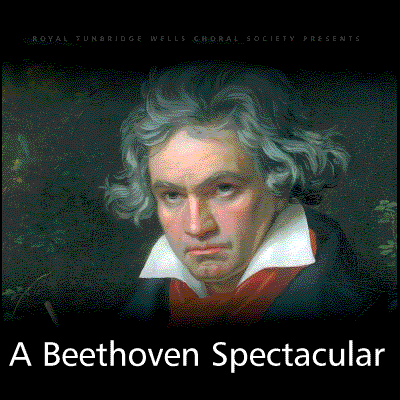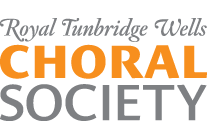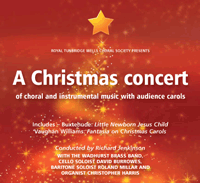106th Season (2009 – 2010)
Beethoven Spectacular

Sunday 18th April 2010
Coriolanus Overture
Choral Fantasia
Mass in C Major
Here’s a contentious thesis: good music-making is democracy in action. Discuss. What I mean is that, done properly, a performance should be a conversation in which all the participants have an equally important voice. Of course some have more to say, and some say it louder. But without all the voices, the conversation is incomplete.
OK, maybe I’m stretching the analogy a little, but my point was amply made last Sunday by performances of three Beethoven masterpieces by the Royal Tunbridge Wells Choral Society and its orchestra, conducted by Richard Jenkinson. Time and again the vital importance of listening to one another – as well, of course, of watching the conductor – was amply demonstrated. This was music-making of the highest order, and from the commanding first gestures of the Coriolan overture it was evident that every member of the orchestra was not only fully up to the task playing Beethoven’s sometimes fiendishly difficult notes, but also knew what role he or she had to play in that magnificent tragedy. There was a real urgency in the string figures which open and permeate the whole piece, and if there was occasional roughness in the ensemble this can be attributed to exuberant enthusiasm, rather than carelessness.
“a blazing contribution from the magnificent massed forces of the RTWCS”The Choral Fantasia is a curious piece which betrays its hurried genesis, and this in turn passes on particular problems to the performers. The solo piano part was originally improvised by Beethoven and not written down until later. Any performance therefore needs to have an improvisatory feel, as if inspiration for each note is seizing the performer at the moment of playing them. On the other hand, the structure of the work is so loose and episodic, it can, in the wrong hands, appear to wander aimlessly. The challenge for the pianist, the conductor and all the performers is to find a way of doing it that finds a balance between improvisation and drive. In my view, this was perfectly achieved on Sunday, and Anthony Zerpa-Falcon must take much of the credit for this. Not only was he well able to cope with all the demands that Beethoven made upon him, but he was remarkably sensitive to all that was going on around him. He had, in my view, a true conversation with the orchestra that gave his performance the intimacy of chamber music as well as the grandeur of the symphony – the perfect combination. But a conversation is a two (or more) -way experience and the members of orchestra who carried on such witty dialogues with Mr Zerpa-Falcon are to be congratulated as well as he. Of course the Choral Fantasia is known and loved mainly for the extraordinary intervention of six soloists and chorus which rounds off the work. The soloists were all superb, in spite a slightly uncertain start, and heralded a blazing contribution from the magnificent massed forces of the RTWCS.
Beethoven had a deep Christian faith but also a profound faith in humanity and this shines through in all his work, including his sacred music. The Mass in C, now forever in the shadow of its wilder younger sibling the Missa Solemnis, is nonetheless a deeply-felt work that came from the composer’s heart. Here again we saw all the forces, chorus, orchestra and soloists making their own vital contribution to a magnificent whole, and fully alive to the text of the mass. Beethoven responds to every twist and turn of the drama: am I alone in hearing an echo of the Fidelio dungeon scene at the words “He suffered and was buried”? All four soloists Sarah Redgwick (soprano), Katherine Allen (mezzo), Sean Clayton (tenor) and Samuel Evans (baritone) made light of their frequently taxing lines and blended well with each other and with the various soloists within the orchestra. The solo cello in the Benedictus, for example, was most beautifully played, as were the many woodwind contributions throughout the mass, and went straight to the heart of this listener.
To complete the ‘conversation’ analogy, when a lot of people have something to say, you need a good chairman. If ‘chairman’ appears to demean the role of Richard Jenkinson, I mean it as the highest praise. In fact, I would go further and say that humility – humility to Beethoven’s music – was the guiding principle of Mr Jenkinson’s performance. Some conductors appear to regard the music as a conduit for demonstrating their own genius. With Mr Jenkinson it was the reverse – he became a conduit for projecting the genius of the music and that, in my view, is what it is all about.
©John Marshall
Remembrance Sunday Concert
Purcell Te Deum, Jubilate & Funeral Sentences
Karl Jenkins’ Armed Man
Assembly Hall, Tunbridge Wells, 8th November 2009
The Royal Tunbridge Wells Choral Society put on a concert of music much of which was most appropriate for Remembrance Sunday, 8th November at the Assembly Hall Theatre, Tunbridge Wells. The first half of the programme was devoted to music by Henry Purcell comprising the Te Deum and Jubilate settings in D major and the Funeral Sentences with March and Canzona; the second half was a most moving account of Karl Jenkins’ The Armed Man: a Mass for Peace.
Like Mozart, Purcell was a great composer whose life was cut short in his mid-thirties but who managed to write a huge amount of music of the highest quality in a wide variety of genres. Much of Purcell’s choral music was written for the choristers at the Chapel Royal.In the excellent programme notes for the Purcell pieces (by William Gould & Ivor Keys) we are told that the Te Deum and Jubilate were originally intended for the opening of St Paul’s Cathedral. Fortunately for us Purcell composed them well in advance as the cathedral was not completed until 15 years after his death.
In the Te Deum we heard the 3 soloists – Kristin Finnigan mezzo soprano, John McMunn tenor and Peter Braithwaite baritone – in various combinations singing the more lyrical and reflective sections interspersed amongst the more robust choral sections. Each of the soloists has an impressive curriculum vitae and sang magnificently but the balance was occasionally spoiled because the tenor was overpowering in several sections. This is a minor quibble and imbalances can happen very easily when soloists are brought together probably for the first time on the day of the concert.
The Jubilate has a much shorter text. It is introduced in regal fashion by the organ and principal trumpeter and the first lines are given to the soprano soloist. Thereafter the chorus takes over and the quality of the singing was fresh and decisive; much more so than in the Te Deum where the singing, especially of the sopranos, was often quite hesitant.
Richard Jenkinson had brought together some extremely talented musicians whose contribution throughout the entire concert was unfailingly brilliant. Organist Christopher Harris took on the lion’s share of the accompaniment throughout the programme. Although an electronic instrument, the sound was remarkably convincing due in no small part to Christopher’s masterly choice of registration and unwavering technique. He was very ably joined by 3 trumpeters (Edward Maxwell, Richard Hammond and Richard Thomas), a huge array of percussion (John Rockliffe, Chris Nall and Donna-Marie Landowski), Anna Stokes on flute and piccolo, Nigel Bromley on cello and Anthony Zerpa-Falcon (the society’s regular accompanist) on piano.
The instrumental sections of the Funeral Sentences were played magnificently. The introduction to the Funeral Sentences is a slow March played by the organ, brass and drums which very much sets the mood and is repeated at the end. The Canzona is played towards the end of the work just before the unaccompanied choir sings “Thou knowest, Lord, the secrets of our hearts” – a setting that is sometimes sung as a separate anthem in church services and is probably the best known part of this work. The tenors and basses produced some nice sounds especially early on but the sopranos were hesitant and unsure of whether thirds were major or minor – especially so in one of the chromatic sequences. In mitigation, this is difficult music for the voices and clearly rehearsal time had been geared towards learning the large score of Jenkins Mass.
“The effect was heightened by the simultaneous film sequences that were projected onto a screen above the choir”After the interval, the choir re-established its confidence and, I have to say, gave a most moving account of The Armed Man: a Mass for Peace by Karl Jenkins. The effect was heightened by the simultaneous film sequences that were projected onto a screen above the choir, reflecting the mood of each of 13 sections.
Again the excellent programme notes were very informative – this work is the latest in a six century old tradition of “Armed Man” masses which take, as their common starting point the 15th century French song L’Homme Arme. Jenkins wrote it as the conflict in Kosovo was unfolding and dedicated it to the victims there. This is writing on a large scale with texts taken not only from the Ordinary of the Mass (Kyrie, Sanctus, Agnus Dei and Benedictus) but also from the Psalms (56 & 59 in Save me from the bloody men), the Koran and by such authors as Kipling, Dryden, Swift and Tennyson.
The opening Armed man chorus starts with drum and piccolo. The upper voices then make their entrance followed by the men, then the trumpets, then the organ and finally the piano. Quite a build up for such a short chorus. Then follows The call to prayer sung by a muezzin from the local Camden Rd Mosque – sung very well (although I am no expert here) but sounding disappointingly like a recording rather than a live performance.
As the music unfolded I was struck by the tremendous variety in textures, the seemingly limitless combinations of chorus, instrumentalists and soloists but mostly by the mix of musical styles, ranging from Palestrina right through to modern dance rhythms and all juxtaposed so strikingly. The Kyrie follows the traditional 9-fold pattern starts with a dark cello solo (with supporting organ). The chorus echo the words sung by the soprano soloist.
Save me from the bloody men is for unaccompanied chorus in unison ending with a rude awakening from the bass drum. The Sanctus will have been instantly recognisable to listeners of Classic FM where it is frequently played. The effect of the piano and percussion accompaniment against the chanting chorus is hypnotic and gradually rises to fortissimo.
Charge!, Angry flames and Torches are the most dramatic of all the movements, describing the devastating effects of the atomic bomb and people as “living torches”. The choir are bathed in red light, symbolic of all the blood shed. The film simultaneously shows footage of the A-bomb and the terrorist attack on and demolition of the twin towers in New York – horrific examples of the absolute tragedy of the needless loss of so many human souls.
The final four movements (starting with the Agnus Dei) deal with the aftermath of war from the grim job of sorting through the rubble to find the dying and the dead and finally the start of the rebuilding of lives, communities and infrastructure. The audience remained silent after the final unaccompanied chorus with text from the book of Revelation (“God shall wipe away all tears”). “We had all been through an emotional journey”We had all been through an emotional journey – singers, instrumentalists, soloists and audience. Finally the silence was broken by tumultuous applause in recognition of a truly remarkable performance from all the musicians.
The Armed Man brought out the best singing I have yet to hear from the RTW Choral Society and one can only imagine the sweat (and tears) that went into the many rehearsals beforehand to reach such a confidant and moving performance. Bravo Richard Jenkinson!
© Paul Jeffries
Click here to read a personal appreciation letter received from Johanna Thorpe.



